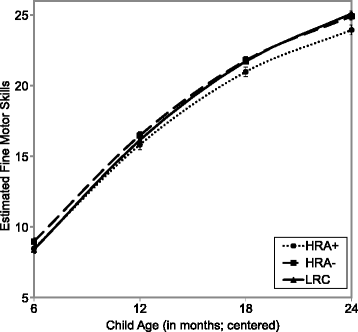Development of fine motor skills is associated with expressive language outcomes in infants at high and low risk for autism spectrum disorder
- PMID: 29649977
- PMCID: PMC5898056
- DOI: 10.1186/s11689-018-9231-3
Development of fine motor skills is associated with expressive language outcomes in infants at high and low risk for autism spectrum disorder
Abstract
Background: A growing body of research suggests that fine motor abilities are associated with skills in a variety of domains in both typical and atypical development. In this study, we investigated developmental trajectories of fine motor skills between 6 and 24 months in relation to expressive language outcomes at 36 months in infants at high and low familial risk for autism spectrum disorder (ASD).
Methods: Participants included 71 high-risk infants without ASD diagnoses, 30 high-risk infants later diagnosed with ASD, and 69 low-risk infants without ASD diagnoses. As part of a prospective, longitudinal study, fine motor skills were assessed at 6, 12, 18, and 24 months of age and expressive language outcomes at 36 months using the Mullen Scales of Early Learning. Diagnosis of ASD was determined at the infant's last visit to the lab (18, 24, or 36 months) using the Autism Diagnostic Observation Schedule.
Results: Hierarchical linear modeling revealed that high-risk infants who later developed ASD showed significantly slower growth in fine motor skills between 6 and 24 months, compared to their typically developing peers. In contrast to group differences in growth from age 6 months, cross-sectional group differences emerged only in the second year of life. Also, fine motor skills at 6 months predicted expressive language outcomes at 3 years of age.
Conclusions: These results highlight the importance of utilizing longitudinal approaches in measuring early fine motor skills to reveal subtle group differences in infancy between ASD high-risk and low-risk infant populations and to predict their subsequent language outcomes.
Keywords: Autism; Early development; Expressive language; Fine motor skills; Infant siblings.
Conflict of interest statement
Ethics approval and consent to participate
This study was approved by the Institutional Review Boards (IRBs) at Boston University and Boston Children’s Hospital (#X06-08-0374). Written, informed consent was obtained from all caregivers prior to their infants’ participation in the study.
Consent for publication
Not applicable.
Competing interests
The authors declare that they have no competing interests.
Publisher’s Note
Springer Nature remains neutral with regard to jurisdictional claims in published maps and institutional affiliations.
Figures
References
-
- American Psychiatric Association. Diagnostic and statistical manual of mental disorders. 5th ed. Arlington: American Psychiatric Publishing, Inc.; 2013.
Publication types
MeSH terms
Grants and funding
LinkOut - more resources
Full Text Sources
Other Literature Sources
Medical
Research Materials
Miscellaneous


